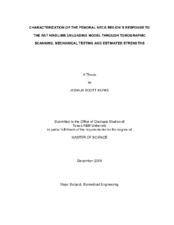| dc.description.abstract | Bone quality and the conditions that affect it make up a large field of study. One specific area of interest is the loss in bone strength during exposure to microgravity. The femoral neck (FN) region in particular is an important region of study since a FN failure has such a detrimental effect on mobility. The objective of this study was to characterize the effects of microgravity and recovery on the FN in the adult male hindlimb unloaded (HU) rat model. This was done through peripheral quantitative computed tomography (pQCT), mechanical testing in two different loading conditions, and estimated strength indices.
Adult male Sprague-Dawley rats (6-mo) were grouped into baseline (BL), ambulatory cage control (CC) and hindlimb unloaded (HU); HU and CC animals were further divided into sub-groups (n=15 each): HU euthanized after 28 days of suspension, and HU euthanized after 28, 56, and 84 days of recovery with CC groups being euthanized at each of these time points. The excised right and left femoral necks were both scanned ex vivo using pQCT. Quasi-static mechanical testing was performed with the right femurs positioned vertically and the left femurs positioned laterally at a -10 degree angle. A series of strength indices was used to attempt to predict the mechanical testing results, including a compression index, a bending index and an alternative combination of the two.
HU exposure led to 6.3 percent lower bone mineral content (BMC), compared to BL and 7.8 percent lower total volumetric bone mineral density (vBMD) at the FN. The vertical or axial loading showed a 17.1 percent drop in mechanical strength due to HU exposure. The lateral loading test revealed a 5.4 percent drop in strength, showing that HU had a greater effect on the axial loading configuration. Also, after just 28 days of recovery, the axial loading test revealed a complete recovery of strength.
None of the strength indexes completely predicted the mechanical behavior of the FN. In the right femur, the combined index had the highest correlation with an R value of 0.94. The bending strength index had the highest correlation in the left lateral testing with an R value of 0.98. However, in all the cases, the strength indexes failed to predict the mechanical behavior at all the time points. In general, the strength indexes provide valuable input, but fail to replace mechanical testing. | en |


